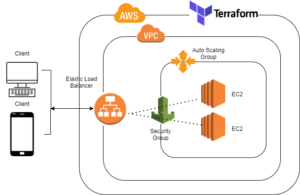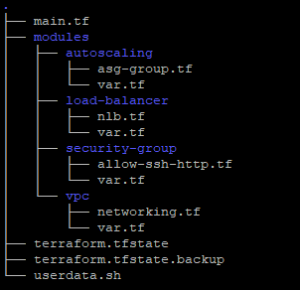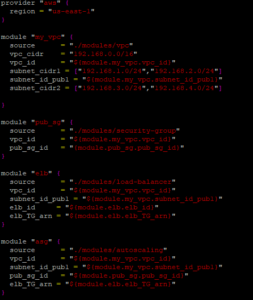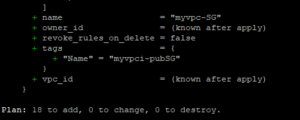Deployment and infrastructure management is not a simple process; in fact, it involves multiple steps and tools to provision infrastructure. We need tools that make this process seamless, easy, and effective. Take Terraform, a tool used to provision and manage infrastructure within any cloud. This open-source tool created by HashiCorp allows you to codify your infrastructure as versioned, declarative configuration files to share and review.
We’ll go over the advantages of Terraform, as well as the categories and practices used to manage infrastructure on AWS cloud.
How to Utilize and Understand Terraform
Not only does Terraform allow you to pack-up your infrastructure as a code, but it also comes with various advantages, such as:
- Automated infrastructure provisioning
- Evolve and version your infrastructure
- Collaborate and share infrastructure configuration
- Mapped resources and dependencies
- Separation of a plan and apply
- Combine multiple cloud providers
- Shared modules of common infrastructure pattern
- Re-use configuration for similar infrastructure
- Avoid mistakes and save time
Writing Terraform Configuration
There are two formats we can use to write Terraform configuration code that is in HCL language (.tf) or in json format (.tf.json). I recommend HCL, as the json format is a targeted machine with auto-generation rather than human-specified code, and Terraform files mostly deal with resources and data sources.
Understanding Commands
Terraform works by detecting current infrastructure tests and calculating the difference between the known and desired state. We can check with these two commonly used commands: “Terraform Plan”, which generates and shows the execution plan, and “Terraform Apply”, which builds or changes within the infrastructure.
Terraform also includes commands that perform several different acts, such as:
- Terraform Console: An Interactive console for Terraform interpolations
- Terraform init: An initialized Terraform working directory
- Terraform Destroy: Destroy Terraform managed infrastructure
- Terraform env: The workspace management
- Terraform fmt: Re-write configuration files to conical format
- Terraform get: Download and install modules for configuration
- Terraform validate: Validate Terraform configuration file
- Terraform import: Import existing infrastructure into Terraform
- Terraform show: Inspect Terraform state or plan
- Terraform version: Print the Terraform version
- Terraform output: Read output from Terraform state file
Types of Terraform Modules
Every Terraform configuration has at least one module known as its root module, which consists of the resource defined in the *.tf file in the main working directory. The root module is the container of resources that we use together, and the root module can call onto another module.
Types of Terraform Variables
Input variables serve as parameters for a Terraform module, allowing for customization of the module’s aspects without altering the module’s source code, and allowing the sharing of modules between different configurations. When you declare variables in the root module of your configuration, you can set their values using CLI options and environment variables.
Best Practices for Using Terraform on AWS Cloud
To ensure you are using Terraform to its best ability within AWS Cloud, follow these pre-configuration steps:
To ensure you are using Terraform to its best ability within AWS Cloud, follow these pre-configuration steps:
- Install Terraform using this link: https://learn.hashicorp.com/tutorials/terraform/install-cli
- Download Terraform Code: https://github.com/amitmehar123/AWS-TF
Connect your Linux base Terraform machine with your AWS account using the below steps:
- In the AWS console, click “create a new user” in the IAM Section.
- Select “Programmatic Access” below and enter your user details.
- Attach the “AdministratorAccess” policy to the user.
- Review and create.
- Download Programmatic Access
- Install AWS CLI on Terraform installed machine and run “aws configure”
- Provide the access key and secrete access with the region by selecting “us-east-1”.
- View how Terraform works within the AWS architecture.

You’ll see the deployment of the application on Ec2 instances, which are part of the auto-scaling group. Then, the Load Balancing applies to the auto-scaling group of instances with the HTTP firewall setup. All resources are created using the Terraform module’s base directory structure, with changes applied through main.tf configuration file and apache web server configured on instances using userdata.sh.
Using a Folder structure, Terraform environments (and their states) are separated by directories and Terraform loads all *.tf files in a directory into one namespace without any specific order.

In this image, we develop the Terraform configuration template and perform any type of Terraform operation. The main configuration template, Main.tf, is the file where we describe all resources to deploy on AWS cloud in the us-east-1 region.

- Check with the Terraform Plan to ensure all resources are correctly deployable with no errors. The correct output shows “Plan: 18 to add, 0 to change and 0 to destroy”.

- Finally, run the “Terraform Apply” command to perform a build and deploy changes on AWS Cloud infrastructure. The Output below shows all 18 resources are deployed successfully in AWS Cloud. If you want to destroy the resources, just run the “Terraform Destroy” command.

Terraform is Valuable for Managing Infrastructure
Learning new subjects and tools is always worth adding to your technical skillset, and tools such as Terraform can change how you manage or provision your AWS Cloud infrastructure simply and effectively. To learn more about implementing Terraform into your technical infrastructure, please contact our experts today.

